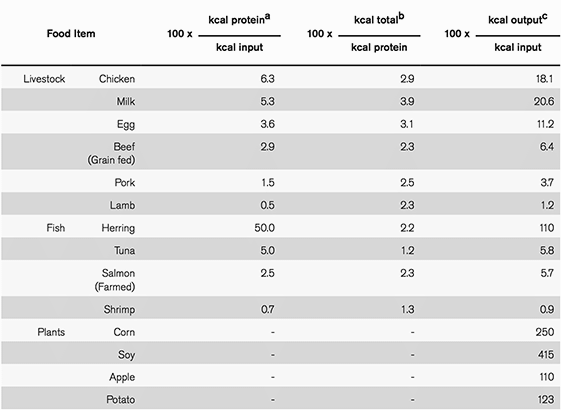Energy
The world population is 7 billion today, and there will be as many as 10 billion in the world in near future. 1 Moreover, we are getting 4.2 million more every single month on this planet, which is approximately 10 more whole Finnish population annually. All things considered, calorific efficiency and energy use in terms of food supply comes into play in a very significant way for the welfare of future generations.

Energetic efficiencies for a few representative food items derived from land animals, aquatic animals, and plants 2
A. Energy input refers to fossil fuels 3
B. Assuming 1 gram protein = 4 kcal and using U.S. Department of Agriculture (2005) value
C. For animal products, the product of the previous two columns
Grain-fed beef requires thirty-five calories for every calorie of beef produced not includ- ing the energy used in processing and transporting food.1 Given the current animal farming practices are highly dependant on synthetic fertilizer made out of natural gas, the calorific efficiency will be increasingly important as the fossil fuel is depleting.
Fossile Fule Usage
The biggest share of fossil fuel usage in industrial farming is not transporting food or fueling machinery, but chemicals. As much as forty percent of energy used in the food system goes towards the production of artificial fertilizers and pesticides. 4 Fertilizers are synthesized from atmospheric nitrogen and natural gas, a process that takes a significant amount of energy. Producing and distributing them alone requires an average of 5.5 gallons of fossil fuels per acre 5 — approximately 1 liter for every 200 square meter.
Manure could be a more energy-efficient alternative to synthetic fertilizers, but because it is heavy this applies only when it can be used a short distance from where it is produced — and our industrial system precludes this option. 6 The problem is over-consolidation: We raise large numbers of livestock in one place and raise the grain they eat in other places. This means that the livestock produce an excess of manure where there’s no cropland for it to be spread on, making it a pollutant rather than a tool. Meanwhile, the fields that grow feed must draw their fertility from synthetic sources. 7 We end up with concentrations of unusable manure in one place, and concentrations of chemical fertilizers in the other — and a whole lot of fuel wasted trucking feed and fertilizer around the country.
Posted by Seungho Lee
References
- B Crossette, R Kollodge, R Froseth, W Haug, A Toure, S Wong, R Kollodge & R Puchalik, The State of World Population 2011: People and Possibilities in a World of 7 Billion, Information and External Relations Division, the United Nations Population Fund (UNFPA), New York. ↑
- G Eshel & PA Martin, Diet, Energy, and Global Warming, Earth Interactions, Vol. 10, Paper No. 9, 2005, p. 6. ↑
- D Pimentel, and M Pimentel, Energy use in livestock production. Food, Energy and Society, University Press of Colorado, 1996, pp. 77-84. ↑
- MC Heller, AK Gregory, Life Cycle-Based Sustainability Indicators for Assessment of the U.S. Food System, Ann Arbor, MI: Centre for Sustainable Systems, University of Michigan, 2000, p. 40. ↑
- R Manning, ‘The Oil We Eat: Following the Food Chain Back to Iraq’, Harper’s, 23 July 2004, retrieved 20 March 2012, link. ↑
- C Heeter, The Oil in Your Oatmeal: A Lot of Fossil Fuel Goes into Producing, Packaging and Shipping Our Breakfast, San Francisco Chronicle, 26 March 2006, retrieved 29 March 2012, link. ↑
- K Clancy, Greener Pastures: How Grass-fed Beef and Milk Contribute to Healthy Eating, Union of Concerned Scientists, Cambridge, 2006, p. 13. ↑